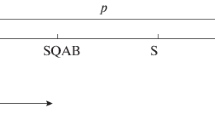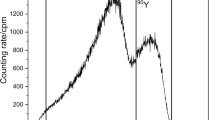Abstract
A method is proposed for the simultaneous determination of anions and cations of chelating metals based on anion chromatography with the chemical suppression of electrical conductivity of the mobile phase. It is distinguished by a high selectivity of the separation of groups of anions and cations. To implement the method, a special treatment of the protecting precolum with a nano-cation exchanger hydrosol solution is carried out and a special mode of operation of the automatic sample introduction device is used. The developed method can be implemented on any ion chromatograph. Examples of rapid analyses of tap and mineral waters for the concentration of inorganic anions, hardness salts, and zinc and copper impurities are given.
Similar content being viewed by others
Avoid common mistakes on your manuscript.
In analyzing the ionic composition of solutions, information is often required both on anions and on cations: in mineral water, along with the anion composition, it is important to know the concentrations of hardness salts and toxic metals; in environmental monitoring, it is necessary to know not only the concentration of trace elements, but also their degree of their oxidation in the cationic and anionic forms of an element (problem of speciation analysis). Two systems are used to obtain this information in ion chromatography: cationic and anionic. The systems are mutually independent and, in fact, are two ion chromatographs. For the convenience of single sample injection and reducing the cost of equipment, methods for the simultaneous determination of anions and cations are being developed. They use one-column versions with column packings exhibiting both anion-exchange and cation-exchange properties and a mobile phase finely selected both in terms of elution force characteristics, which are dictated by both cation and anion separation, and in terms of detection characteristics [1, 2]. Such a combination of functions has certain disadvantages associated with the lack of a possibility of using the chemical suppression of electrical conductivity, i.e. with a loss of sensitivity, and with the mutual effect of anions and cations, peaks of which are recorded in the same region of the chromatogram. Some authors use a possibility of chemical suppression in the anionic system, introducing a chelating additive into the eluent, but, in this case, the mutual effect of anions and anionic metal complexes, which reduces the resolution of the method, is still observed [3].
Earlier, we proposed a method for the simultaneous determination of anions and cations based on the bipolarity of separating KanK adsorbents [4–6]. Like its counterparts, the method provides a single sample injection and the reduction of the cost of equipment. The difference and an advantage of the proposed method are in the absence of the mutual effect of the anionic and cationic compositions on the peak resolution and in maintaining the high sensitivity of detection because of the use of the chemical suppression of the electrical conductivity of the eluent. In commercial chromatographs such a method cannot be implemented directly because of the absence of cation exchange capacity in the anion exchange phases used, stopping the cations.
The procedure proposed in this article makes it possible to realize the indicated method in any ion chromatograph. The technical implementation of the simultaneous determination of anions and cations became possible because of the use of a nanosized ion exchanger [7, 8] for the treatment of the guard column installed before the separation column.
EXPERIMENTAL
Reagents. A 4 mM solution of a chelating ligand (CL), EDTA (reagent grade), in water was used. The eluent was prepared from sodium carbonate, a 0.5 M solution; sodium hydrogen carbonate, a 0.5 M solution; and the CL. The eluent composition was 1 mM NaHCO3, 3.2 mM Na2CO3, and 0.001 M CL. A solution for the regeneration of the chemical suppressor was a 0.2 M sulfuric acid. The auxiliary solution for treating the precolum was hydrosol of a NIK-2 nano-cation exchanger in the H-form with the concentration of functional groups 0.038 M, prepared by a special procedure developed at the Institute of Geochemistry and Analytical Chemistry of the Russian Academy of Sciences [8, 9].
To prepare analytes, solutions of anion salts (F–, Cl–, \({\text{NO}}_{2}^{ - },\) Br–, \({\text{NO}}_{3}^{ - },\)\({\text{HPO}}_{4}^{{2 - }},\) and \({\text{SO}}_{4}^{{2 - }}\)) with a concentration of 1 g/L in the anion and metal salts (Mg2+, Ca2+, Zn2+, and Cu2+) with a concentration of 1 g/L in the cation prepared from precisely weighed portions were used. The standard mixture contained the following ions, ppm: 2 F–, 17.7 Cl–, 15 \({\text{NO}}_{2}^{ - },\) 15 Br–, 20 \({\text{NO}}_{3}^{ - },\) 25 \({\text{HPO}}_{4}^{{2 - }},\) 50 \({\text{SO}}_{4}^{{2 - }}\), 5 Mg2+, 10 Ca2+, 10 Zn2+, and 8 Cu2+.
Equipment. A Metrohm ion chromatograph (Switzerland) of the 883 Basic IC plus brand with a conductometric detector and the chemical suppression of electrical conductivity was used. The analytical system of the chromatograph consisted of an injector with a 20 µL metering loop, a Metrosep A Supp 5 – 150/4.0 separation anion-exchange column with a Metrosep A Supp 4/5 Guard/4.0 precolum, and a node with three miniature MSM suppressing columns, each time incorporating freshly regenerated column into the new experiment. The arrangement and characteristics of the chromatograph are presented on the website of the company [10].
The procedure of precolum special treatment. To implement the method on 883 Basic IC plus ion chromatograph, a node with Metrosep A Supp 4/5 Guard/4.0 precolum was specially treated. The precolum was treated with the aim to impart cation-exchange properties to it by passing 10 mL of a NIK-2 auxiliary solution through it, after which it was thoroughly washed with acetonitrile and water (Fig. 1). After such treatment, all the protective functions of the precolum were restored.
RESULTS AND DISCUSSION
The proposed method was applied to the highly selective analysis of the anionic and cationic composition of aqueous solutions in a single sample injection using an anion-exchange ion chromatography system with chemical suppression without sample preparation and in a reasonable time (about 20 min).
The idea of the method [4] is in the separate elution of the sample anions and those cations that form anionic complexes stable under the experimental conditions, created at a certain point in time with the help of the CL dispensed through an injector. For the separate elution of anions and cations, a device was installed immediately after the injector to stop and accumulate sample cations.
In our experiments, a specially prepared precolum (Metrosep A Supp 4/5 Guard/4.0) acted as such a device (Fig. 2). The packing of the precolum with anion-exchange properties was modified in a dynamic mode by passing a solution of a hydrosol of a nano-cation exchanger, which passed through the drainage of the column freely. Negatively charged particles of the nano-cation exchanger were deposited and retained on the positively charged surface of the packing granules due to electrostatic forces.
The CL forming strong anionic complexes with the stopped cations was a solution of EDTA with the concentration 3–5 mM. This solution was introduced into the chromatograph system through an injector, which was thoroughly washed with water after the sample. The dosing time was determined by the elution of the last anion, and taking into account the dead time and free space in the chromatogram, to save the analysis time, dosing was carried out 3.5–4 min before the end of the complete separation of the anions. The developed procedure is rather sensitive to the presence of impurities in the eluent forming chelates with the CL; therefore, to mask them, 1/1000 of the CL concentration was added to the eluent.
Of great importance for the reproducibility of the procedure was the automatic sample injection device that was provided with the chromatograph. The program of its work is presented in the Table 1.
In model experiments, a standard solution of seven anions and four cations of a given composition, ppm: 2 F–, 17.7 Cl–, 15 \({\text{NO}}_{2}^{ - },\) 15 Br–, 20 \({\text{NO}}_{3}^{ - },\) 25 \({\text{HPO}}_{4}^{{2 - }},\) 50 \({\text{SO}}_{4}^{{2 - }},\) 10 Ca2+, 5 Mg2+, 10 Zn2+, and 8 Cu2+, was used. In the resulting single chromatogram, first all anions and then cations were eluted. The total analysis time was 21 min (Fig. 3).
The developed method for the simultaneous highly selective determination of anions and cations turned out to be very convenient for the rapid analysis of natural, drinking, and mineral waters. Figures 4 and 5 show chromatograms obtained in the analysis of such samples.
At this stage of development, the proposed method is not free from disadvantages. One can state that the detection of trace components of metals, such as Zn and Cu, in these experiments is still not sufficiently reliable because of the effect of the addition of CL to the eluent. The preliminary purification of the eluent components from chelating impurities and the elimination of the masking CL additive to the eluent will improve the procedure in this aspect.
REFERENCES
Saari-Nordhaus, R. and Anderson, J.M., J. Chromatogr. A, 1991, vol. 549, p. 257.
Tanaka, K., Ohta, K., Haddad, P.R., Fritz, J.S., and Hasebe, K., J. Chromatogr. A, 2000, vol. 884, p. 167.
García-Fernandez, R., García-Alonso, J.I., and Sanz-Medel, A., J. Chromatogr. A, 2004, vol. 1033, p. 127.
Dolgonosov, A.M., React. Polym., 1992, vol. 17, p. 95.
Dolgonosov, A.M., Senyavin, M.M., and Volo-shchik, I.N., Ionnyi obmen i ionnaya khromatografiya (Ion Exchange and Ion Chromatography), Moscow: Nauka. 1993.
Dolgonosov, A.M., J. Chromatogr. A, 1994, vol. 671, p. 33.
Dolgonosov, A.M., Kolotilina, N.K., Yadykov, M.S., and Burmistrov, A.A., J. Anal. Chem., 2013, vol. 68, no. 5, p. 444.
Dolgonosov, A.M., Khamizov, R.Kh., Koloti-lina, N.K., Shaikhina, S.U., and Evstigneeva, P.V., Sorbtsionnye Khromatogr. Protsessy, 2016, vol. 16, no. 4, p. 400.
Dolgonosov, A.M., Kolotilina, N.K., and Yadykov, M.S., RF Patent 2499628, Byull. Izobret., 2013, no. 33.
Metrohm. www.metrohm.com/en/products/ion-chromatography/ic-columns/; http://www.metrohm.com/de-de/unternehmen/news/ 14018-suppression-in-ionenchromatographie/. Accessed January 25, 2018.
ACKNOWLEDGMENTS
The Metrohm ion chromatograph (Switzerland), of the 883 Basic IC plus brand was kindly provided for the period of work (February 2015–July 2015) by ZAO AVRORA Lab under an agreement on scientific and technical cooperation.
Funding
The work was supported by the Program for Basic Research of the Presidium of the Russian Academy of Sciences No. 26 “Fundamental foundations and new effective methods for chemical analysis and research of the structure of substances and materials.”
Author information
Authors and Affiliations
Corresponding author
Additional information
Translated by V. Kudrinskaya
Rights and permissions
About this article
Cite this article
Dolgonosov, A.M., Kolotilina, N.K. Method of the Simultaneous Determination of Anions and Cations Using a Nanosized Cation Exchanger and On-Column Formation of Anionic Chelates. J Anal Chem 74, 550–554 (2019). https://doi.org/10.1134/S1061934819060029
Received:
Revised:
Accepted:
Published:
Issue Date:
DOI: https://doi.org/10.1134/S1061934819060029









